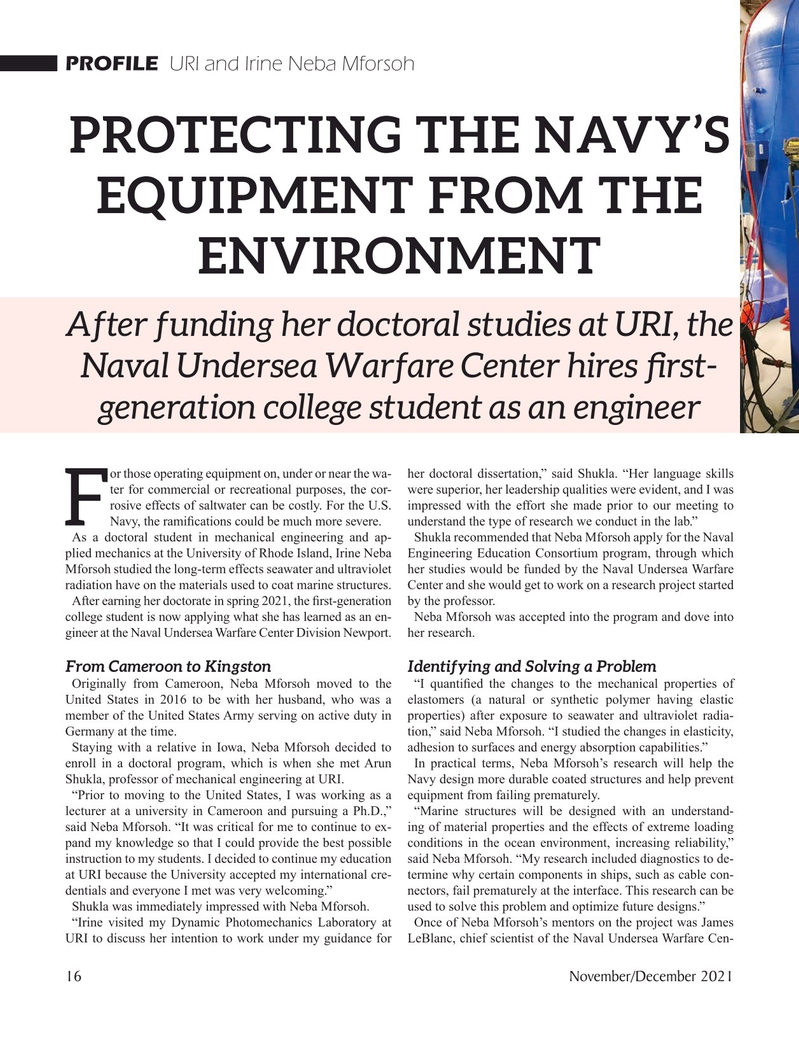
Page 16: of Marine Technology Magazine (November 2021)
Ocean Observation: Gliders, Buoys & Sub-Surface Networks
Read this page in Pdf, Flash or Html5 edition of November 2021 Marine Technology Magazine
PROFILE URI and Irine Neba Mforsoh
PROTECTING THE NAVY’S
EQUIPMENT FROM THE
ENVIRONMENT
After funding her doctoral studies at URI, the
Naval Undersea Warfare Center hires ? rst- generation college student as an engineer or those operating equipment on, under or near the wa- her doctoral dissertation,” said Shukla. “Her language skills ter for commercial or recreational purposes, the cor- were superior, her leadership qualities were evident, and I was rosive effects of saltwater can be costly. For the U.S. impressed with the effort she made prior to our meeting to
F Navy, the rami? cations could be much more severe. understand the type of research we conduct in the lab.”
As a doctoral student in mechanical engineering and ap- Shukla recommended that Neba Mforsoh apply for the Naval plied mechanics at the University of Rhode Island, Irine Neba Engineering Education Consortium program, through which
Mforsoh studied the long-term effects seawater and ultraviolet her studies would be funded by the Naval Undersea Warfare radiation have on the materials used to coat marine structures. Center and she would get to work on a research project started
After earning her doctorate in spring 2021, the ? rst-generation by the professor.
college student is now applying what she has learned as an en- Neba Mforsoh was accepted into the program and dove into gineer at the Naval Undersea Warfare Center Division Newport. her research.
From Cameroon to Kingston Identifying and Solving a Problem
Originally from Cameroon, Neba Mforsoh moved to the “I quanti? ed the changes to the mechanical properties of
United States in 2016 to be with her husband, who was a elastomers (a natural or synthetic polymer having elastic member of the United States Army serving on active duty in properties) after exposure to seawater and ultraviolet radia-
Germany at the time. tion,” said Neba Mforsoh. “I studied the changes in elasticity,
Staying with a relative in Iowa, Neba Mforsoh decided to adhesion to surfaces and energy absorption capabilities.” enroll in a doctoral program, which is when she met Arun In practical terms, Neba Mforsoh’s research will help the
Shukla, professor of mechanical engineering at URI. Navy design more durable coated structures and help prevent “Prior to moving to the United States, I was working as a equipment from failing prematurely.
lecturer at a university in Cameroon and pursuing a Ph.D.,” “Marine structures will be designed with an understand- said Neba Mforsoh. “It was critical for me to continue to ex- ing of material properties and the effects of extreme loading pand my knowledge so that I could provide the best possible conditions in the ocean environment, increasing reliability,” instruction to my students. I decided to continue my education said Neba Mforsoh. “My research included diagnostics to de- at URI because the University accepted my international cre- termine why certain components in ships, such as cable con- dentials and everyone I met was very welcoming.” nectors, fail prematurely at the interface. This research can be
Shukla was immediately impressed with Neba Mforsoh. used to solve this problem and optimize future designs.” “Irine visited my Dynamic Photomechanics Laboratory at Once of Neba Mforsoh’s mentors on the project was James
URI to discuss her intention to work under my guidance for LeBlanc, chief scientist of the Naval Undersea Warfare Cen- 16 November/December 2021
MTR #8 (1-17).indd 16 11/23/2021 10:24:22 AM

 15
15

 17
17
